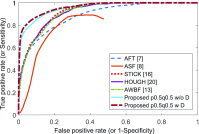Line Detection as an Inverse Problem: Application to Lung Ultrasound Imaging
- PMID: 28682247
- PMCID: PMC6051490
- DOI: 10.1109/TMI.2017.2715880
Line Detection as an Inverse Problem: Application to Lung Ultrasound Imaging
Abstract
This paper presents a novel method for line restoration in speckle images. We address this as a sparse estimation problem using both convex and non-convex optimization techniques based on the Radon transform and sparsity regularization. This breaks into subproblems, which are solved using the alternating direction method of multipliers, thereby achieving line detection and deconvolution simultaneously. We include an additional deblurring step in the Radon domain via a total variation blind deconvolution to enhance line visualization and to improve line recognition. We evaluate our approach on a real clinical application: the identification of B-lines in lung ultrasound images. Thus, an automatic B-line identification method is proposed, using a simple local maxima technique in the Radon transform domain, associated with known clinical definitions of line artefacts. Using all initially detected lines as a starting point, our approach then differentiates between B-lines and other lines of no clinical significance, including Z-lines and A-lines. We evaluated our techniques using as ground truth lines identified visually by clinical experts. The proposed approach achieves the best B-line detection performance as measured by the F score when a non-convex [Formula: see text] regularization is employed for both line detection and deconvolution. The F scores as well as the receiver operating characteristic (ROC) curves show that the proposed approach outperforms the state-of-the-art methods with improvements in B-line detection performance of 54%, 40%, and 33% for [Formula: see text], [Formula: see text], and [Formula: see text], respectively, and of 24% based on ROC curve evaluations.
Figures










Similar articles
-
Detection of Line Artifacts in Lung Ultrasound Images of COVID-19 Patients Via Nonconvex Regularization.IEEE Trans Ultrason Ferroelectr Freq Control. 2020 Nov;67(11):2218-2229. doi: 10.1109/TUFFC.2020.3016092. Epub 2020 Aug 12. IEEE Trans Ultrason Ferroelectr Freq Control. 2020. PMID: 32784133 Free PMC article.
-
Detecting Curvilinear Features Using Structure Tensors.IEEE Trans Image Process. 2015 Nov;24(11):3874-87. doi: 10.1109/TIP.2015.2447451. Epub 2015 Jun 19. IEEE Trans Image Process. 2015. PMID: 26099143
-
Compressive Deconvolution in Medical Ultrasound Imaging.IEEE Trans Med Imaging. 2016 Mar;35(3):728-37. doi: 10.1109/TMI.2015.2493241. Epub 2015 Oct 26. IEEE Trans Med Imaging. 2016. PMID: 26513780
-
Effective Alternating Direction Optimization Methods for Sparsity-Constrained Blind Image Deblurring.Sensors (Basel). 2017 Jan 18;17(1):174. doi: 10.3390/s17010174. Sensors (Basel). 2017. PMID: 28106764 Free PMC article.
-
Current Advances in Computational Lung Ultrasound Imaging: A Review.IEEE Trans Ultrason Ferroelectr Freq Control. 2023 Jan;70(1):2-15. doi: 10.1109/TUFFC.2022.3221682. Epub 2023 Jan 11. IEEE Trans Ultrason Ferroelectr Freq Control. 2023. PMID: 36355735 Review.
Cited by
-
Sonographic Diagnosis of COVID-19: A Review of Image Processing for Lung Ultrasound.Front Big Data. 2021 Mar 9;4:612561. doi: 10.3389/fdata.2021.612561. eCollection 2021. Front Big Data. 2021. PMID: 33748752 Free PMC article. Review.
-
COVID-19 Control by Computer Vision Approaches: A Survey.IEEE Access. 2020 Sep 29;8:179437-179456. doi: 10.1109/ACCESS.2020.3027685. eCollection 2020. IEEE Access. 2020. PMID: 34812357 Free PMC article.
-
Quantitative Analysis of Pleural Line and B-Lines in Lung Ultrasound Images for Severity Assessment of COVID-19 Pneumonia.IEEE Trans Ultrason Ferroelectr Freq Control. 2022 Jan;69(1):73-83. doi: 10.1109/TUFFC.2021.3107598. Epub 2021 Dec 31. IEEE Trans Ultrason Ferroelectr Freq Control. 2022. PMID: 34428140 Free PMC article.
-
Automatic Pleural Line Extraction and COVID-19 Scoring From Lung Ultrasound Data.IEEE Trans Ultrason Ferroelectr Freq Control. 2020 Nov;67(11):2207-2217. doi: 10.1109/TUFFC.2020.3005512. Epub 2020 Jun 29. IEEE Trans Ultrason Ferroelectr Freq Control. 2020. PMID: 32746195 Free PMC article.
-
State of the Art in Lung Ultrasound, Shifting from Qualitative to Quantitative Analyses.Ultrasound Med Biol. 2022 Dec;48(12):2398-2416. doi: 10.1016/j.ultrasmedbio.2022.07.007. Epub 2022 Sep 23. Ultrasound Med Biol. 2022. PMID: 36155147 Free PMC article. Review.
References
-
- Lichtenstein D. A., Mezière G. A., Lagoueyte J.-F., Biderman P., Goldstein I., and Gepner A., “A-lines and B-lines: Lung ultrasound as a bedside tool for predicting pulmonary artery occlusion pressure in the critically ill,” Chest, vol. 136, no. 4, pp. 1014–1020, 2009. - PubMed
-
- Allinovi M., Saleem M., Romagnani P., Nazerian P., and Hayes W., “Lung ultrasound: A novel technique for detecting fluid overload in children on dialysis,” Nephrol. Dialysis Transplantation, vol. 32, no. 3, pp. 541–547, 2017. - PubMed
-
- Nicolò P. D., Magnoni G., and Granata A., “Lung ultrasound in hemodialysis: A card to be played?” Blood Purif, vol. 44, no. 1, pp. 1–7, 2017. - PubMed
Publication types
MeSH terms
Grants and funding
LinkOut - more resources
Full Text Sources
Other Literature Sources
Molecular Biology Databases

